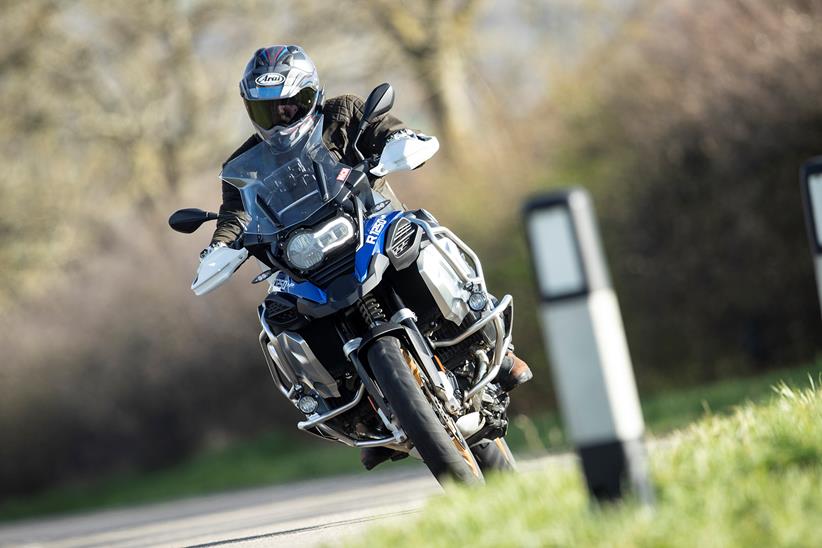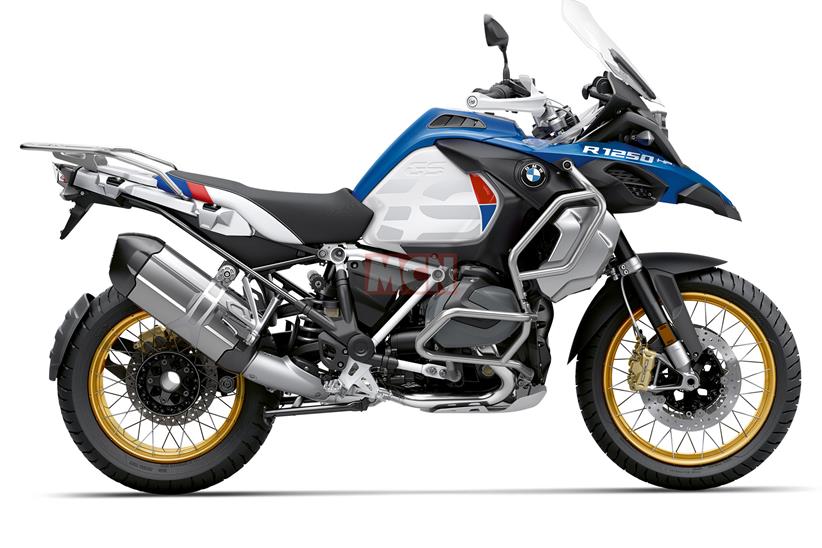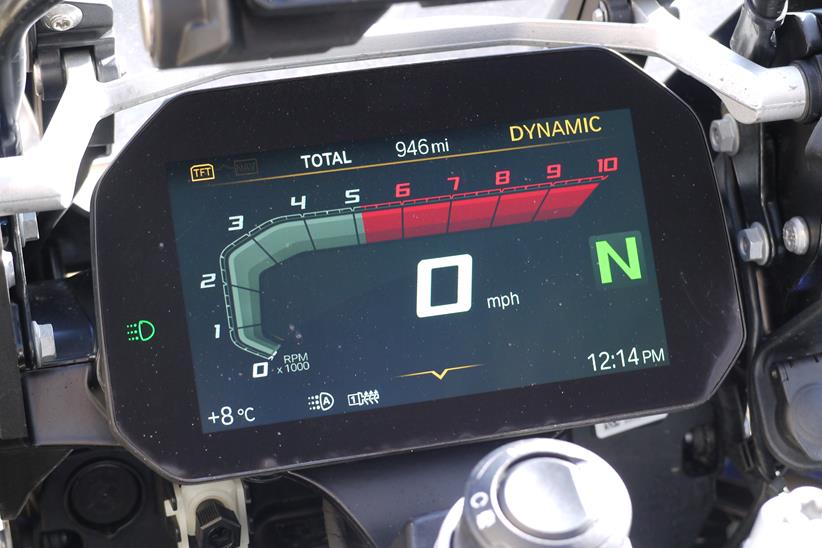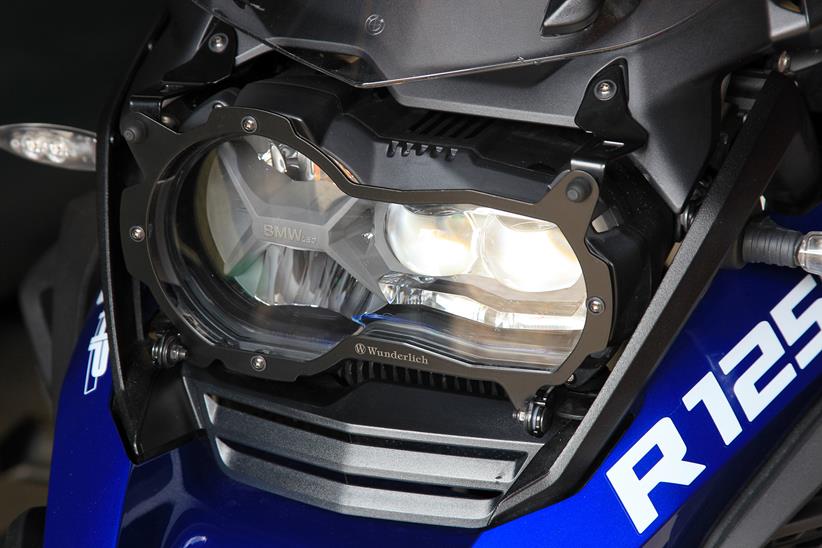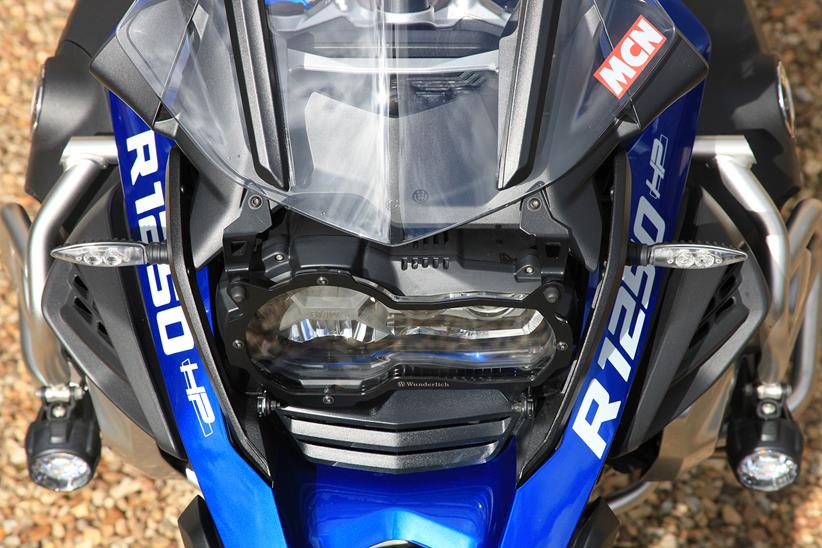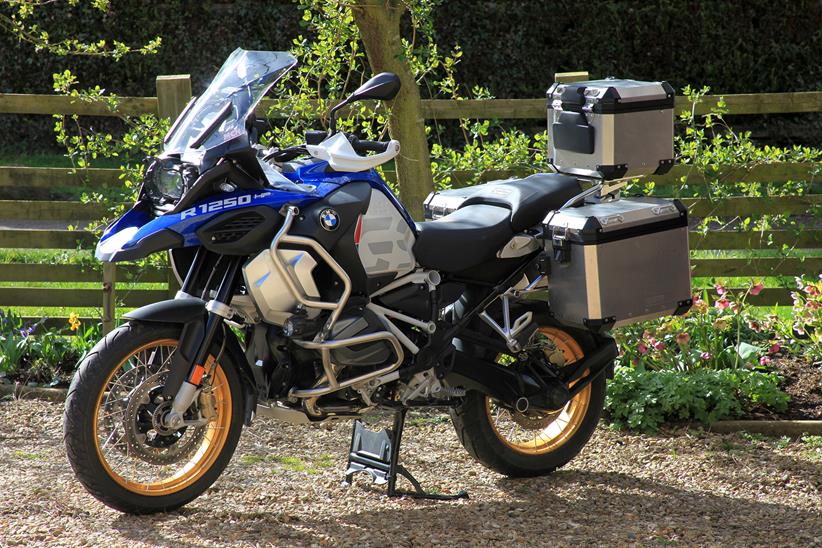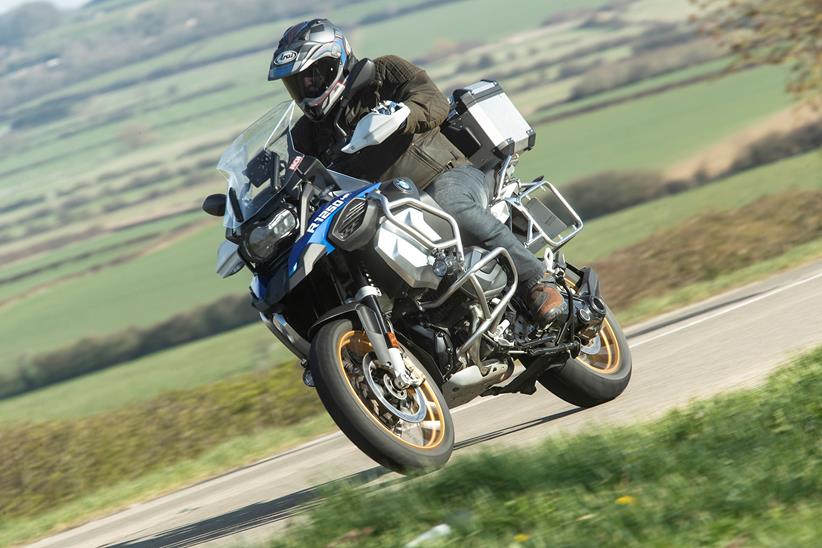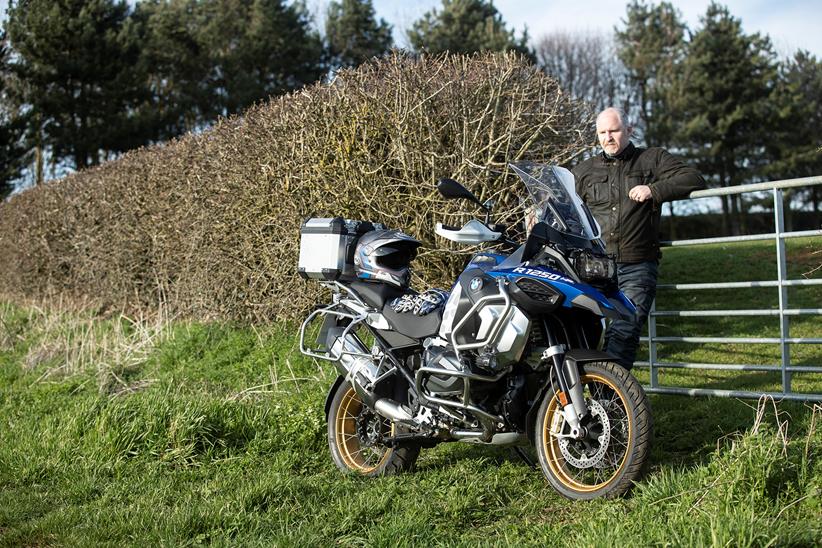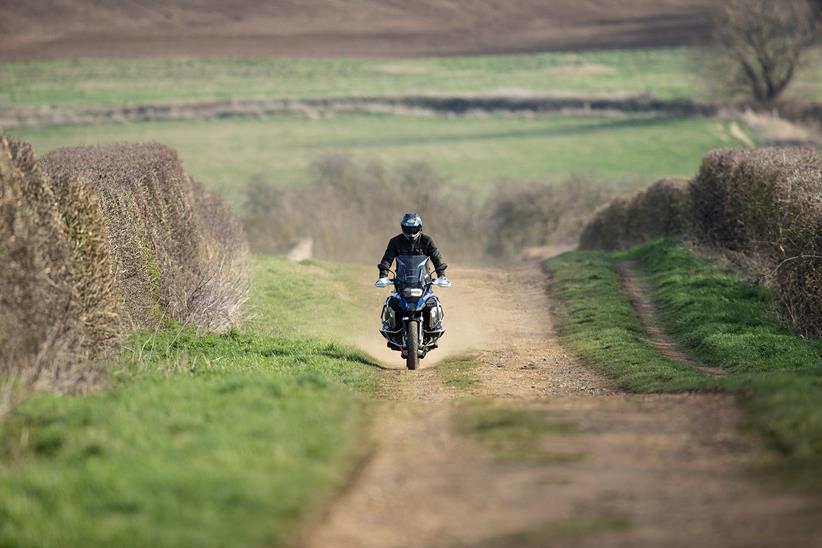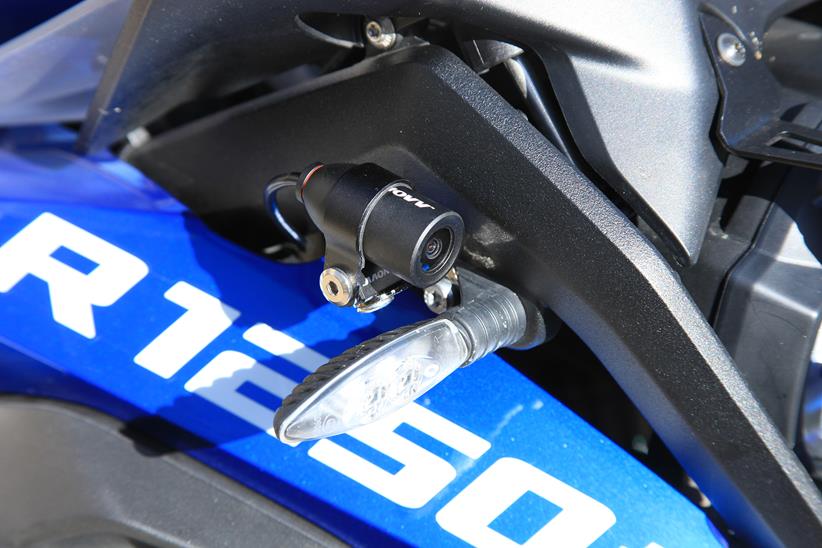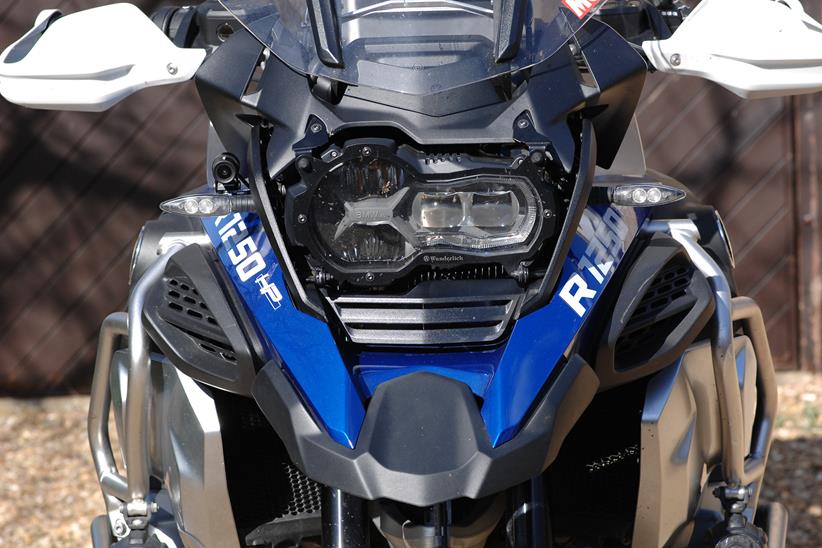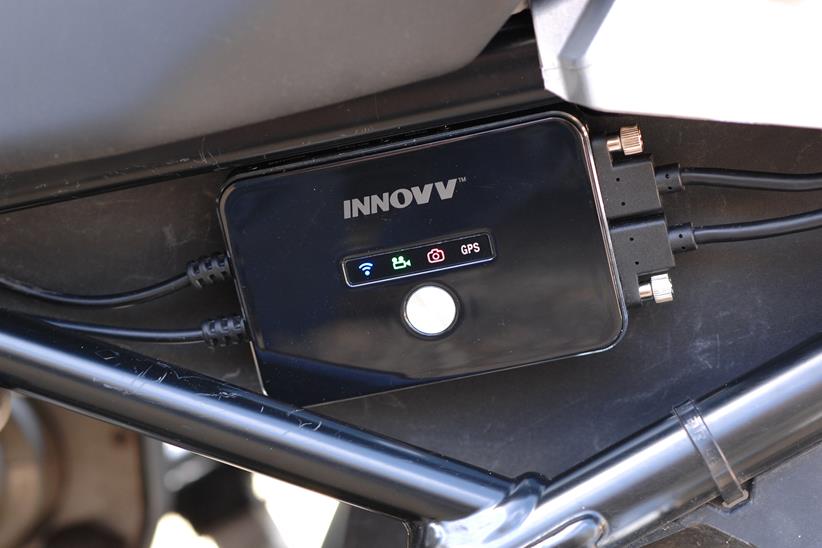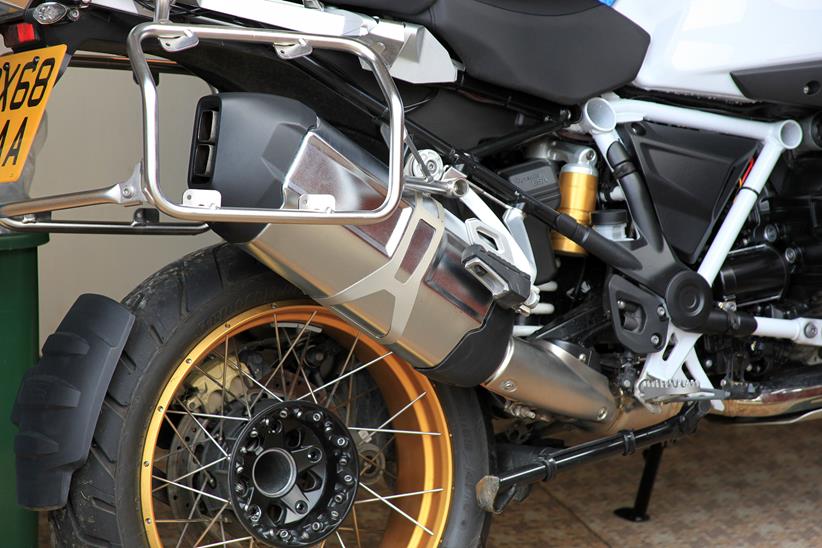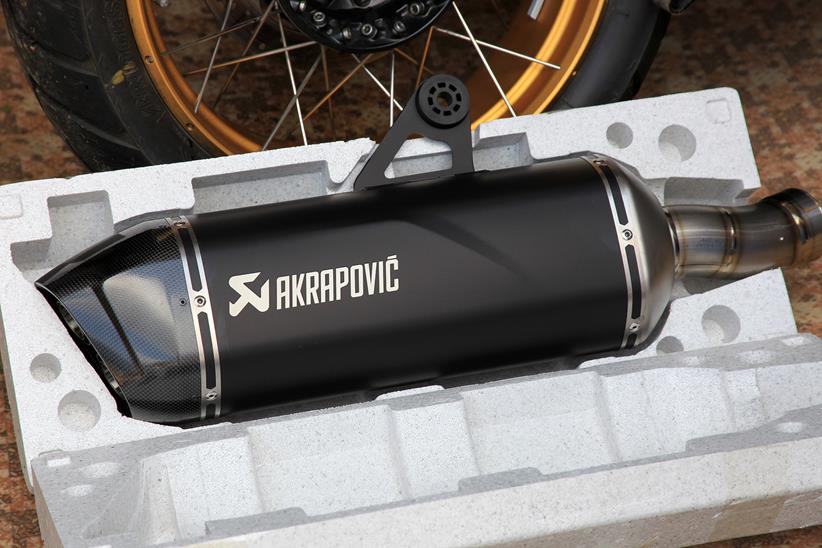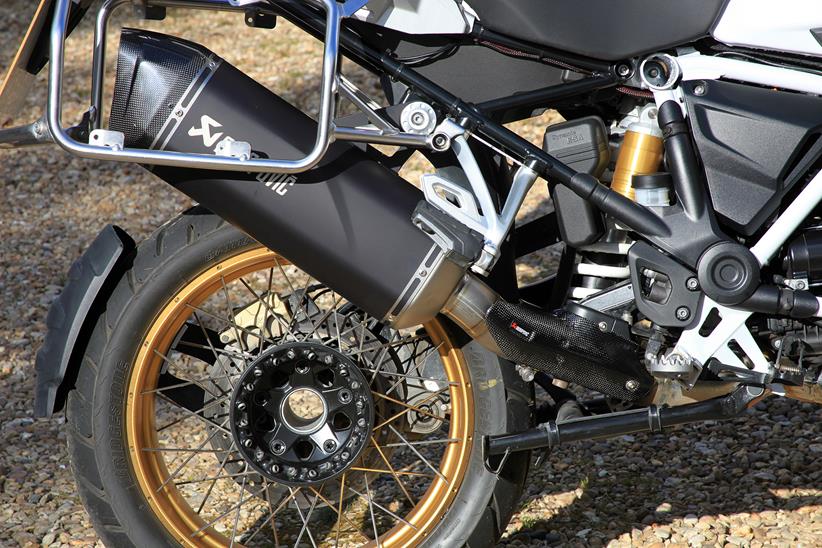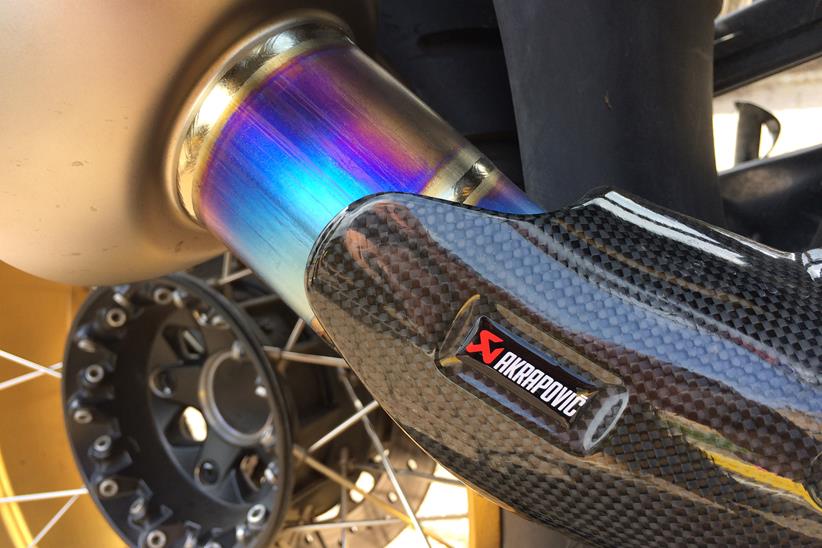MCN Fleet: The BMW R1250GSA is a robot with personality
I really wanted to find a catastrophic flaw in the BMW R1250GSA’s skill set this year. It’s nothing personal, but having covered around 35,000 miles on GSs over the last five years, the cachet of being the one who finally manages to whinge (with supporting evidence) about the GS is an attractive lure. We may demand perfection from bikes, but we’re always oddly disappointed if we find it.
Of course, the GSA isn’t perfect. Nothing is. But picking holes in it is a bit like criticising a supermodel for having a mole on her arse. I’ve said it before, but it’s worth noting that the genius that’s laced into every molecule of the GS has always been hard to pin down. Nothing stands out as its defining glory, it’s the sum of all its talents that somehow manages to impress, despite the ordinary ingredients.
Thumping ShiftCame is a real peach
I would argue that 2019 has given it a bit more of an edge in one regard, though. That new 1250 ShiftCam engine is a thumping peach of an evolution. At any speed, in any gear, it’s transformed the character of the engine. While many mourn the old air-cooled unit as the most engaging and characterful, I reckon the new one has it beat in every sense. There’s drive everywhere in the rev range and I can’t think of any other bike that boasts its flexibility from such low revs. Stick the big GSA in 6th at 40mph and it’ll drive harder than most can if you go back two cogs.
I did say it’s not perfect, though. The engine still suffers a little with vibes that can cause white-finger if you do a long schlep on the motorway at constant revs. You can dial them down a bit with heavier bar weights (I used Evotech bar weights and guard bars) but it’s still there if you hit the sweet spot.
Another major benefit that ended up as an irritation was the new Connectivity TFT dash. In normal use as a device to tell you all the things you need to know while riding, it’s superb – but it’s the ‘connected’ part where it falls down. If your phone is in a pannier or topbox, then the dash can’t hold on to the Bluetooth signal reliably – or get it at all.
![]()
That means you have to have your phone in a pocket, tankbag, or mounted on your bars. But even then its less than seamless in use. It regularly forgets my iPhone and Cardo headset, meaning you have to pair both again, and even when everything is hooked up its reluctant to play music through the dash to your headphones, and phonecalls often drop-out. The navigation and selection of functions relating to both is laboriously joyless, too.
My only other big gripe is the sheer complexity of every angle and facet of the bike. It takes two hours to give it a thorough clean, and you need the patience of a saint and hands the size of a new-born baby to do it. Come on BMW, simplify it a bit.
Gripes aside – if you need the undisputed do-it-all go-anywhere king of all terrain riding, I’d struggle to recommend any other bike more highly.
BMW R1250GSA: The story so far
- Update 1: Introducing the BMW R1250GSA
- Update 2: R1250GSA pros and cons
- Update 3: Electronic upgrades
- Update 4: Akrapovic exhaust added
- Update 5: 3500 miles on the R1250GSA
- Update 6: Good vibrations
- Update 7: Prepping the big GS for adventure
- Update 8: Aftermarket exhaust headers added
- Update 9: Worthwhile accessories for the BMW R1250GSA
Update nine: ‘Don’t waste your money’
Published: 20.11.19
![]()
Magpie syndrome is a serious affliction. ‘See shiny thing – must have shiny thing.’ It’s one of the underlying drivers of our passion for bikes – and the whole industry depends on it to keep afloat. But some of the shiny things are a waste of money – be they whole motorcycles, or the trinkets we bolt to them – and the modern version of the superbike glitterball (result of used £8k superbike having £12k spent on it) is the adventure bike accessory magnet.
The amount of GSs I’ve seen that look like they were covered in glue before ram-raiding the accessories department outweighs the unmolested ones still on the road. So, in the spirit of joining in, I’ve been bolting all sorts of things to the mighty GSA in an attempt to qualify what’s an invaluable buy and what’s just a pleasant way to burn cash.
These are the highlights – mixed with just a few where the dimmer switch is stuck on its lower setting.
Akrapovic full system – HIT
It’s a pricey addition (end can £949, headers £899, performanceparts-ltd.com), but the aural and visceral character released by both transformed every ride. When I switched back to the standard system again it was like listening to music under water. If you only do one; it’s the can for aural pleasure, the headers for a performance lift.
MRA Vario Screen – HIT
The GSA’s standard screen is actually pretty decent, but there’s no denying that the MRA Vario X-Creen delivered a serious improvement in buffeting and overall noise. It’s seriously pricey at £180 (bikehps.com), but comes complete with the large deflector wing, additional stabilising brackets to prevent screen wobble, and a huge range of adjustment.
Wunderlich headlamp protector – HIT
Prevention is usually better than cure and I really like this attractive, functional and well thought-out. At £109 (nippynomans.com), it’s a lot cheaper than a new LED headlamp unit, too. It might not be a big concern on-road, but if you ride stony trails with other riders it’s invaluable insurance. The hinged design makes it easy to clean, and I’ve got nothing but positives to report.
Wunderlich bar bag – MISS
There’s nothing wrong with the quality or intent of this bar bag (£79, nippynomans.com), but I didn’t gel with it at all. The Velcro fitting is secure in use, but it’d be very easy for someone to whip off in seconds at a petrol stop. It’s also a restrictive shape, meaning it’s great for wallet/phone/keys etc but not a lot else. I much prefer using a tank-bag.
BMW hard panniers – HIT
Let’s be honest, there are few bigger biking clichés than a GS with aluminium panniers and topbox. But bloody hell they’re good. Utterly effortless to use, waterproof, rugged, versatile, cavernous, durable, easy to clean. The only thing not to like is their vulnerability in a crash, and the salty cost (£1845 for a full set and rack). I wouldn’t be without them, though.
Kriega soft panniers – MISS
Conversely, despite understanding the benefits of soft luggage and loving Kriega kit, this system just doesn’t boast the usability hard luggage and I don’t think it looks right on the GSA – while it looks brilliant on some bikes, like Yamaha’s Ténéré 700. It’s much cheaper (£622, kriega.com – plus the BMW system rack, £315), but I’d still go for the hard cases.
Evotech bar guards/weights – HIT
The 1250 ShiftCam engine is a peach, but you still get a fair bit of bar vibration. I had two goes at damping it down, and the second was the most effective, which effectively combines the benefit of Evotech’s heavier bar-end weights (£44.99) with a set of hefty aluminium brushguard protectors (£119.99) that wrap the GSA’s original plastic guards.
Innovv K2 camera system – HIT
I’ve lost count of the number of numpties I’ve recorded with the Innovv K2 system – front and rear (from £289.95). Once fitted, you never have to worry about turning it on or off (it’s ignition wired), battery life (because it’s hard-wired), or plugging in to download – simply sync with the app and save what you want. Great quality, features, functionality, and price.
![]()
Evotech engine guard – HIT
BMW’s boxer engine front plates take a serious battering from road crud, aging them prematurely and permanently. This simple bolt-on plate (£52.49, evotech-performance.com) is nothing more complex than a first line of defence, and it works really well. My only criticism would be that a fuller coverage wouldn’t hurt, but it covers the sweet spot.
Wunderlich GoPro mount – MISS
This is such a simple idea, but the position is rather unengaging in playback, unless you add multiple convoluted extensions. It’s well made, fits perfectly and is super-sturdy – although it is made to work with the standard screen and fouled against the MRA. In truth, whenever I mounted a camera I tended to use other camera positions, making this rather redundant.
Hex ezCan – HIT
I’m always wary of adding loads of electrical upgrades to any bike, so when I added the Innovv camera system I also added an ezCan (£195.60, hexinnovate.com) – which allowed me to pick up a switched live without having to carve into the BM’s canbus loom – and you can add and control numerous further electronic add-ons through the system. Top kit.
Update eight: It’s all in your head(ers)
Published: 11.09.19
![]()
Mucking about with exhausts on brand-new bikes has been an expensive act of diminishing returns for a decade now. Parking the obvious benefits of improved aesthetics, ditching the OE hardware for an end can, or even a full system, often results in such an intangible performance boost that many of us have simply given up bothering. Last weekend excepted, I can’t recall the last time I replaced a full system.
But after hearing tales from other BMW 1250GS owners that they’d got a decent boost from a full organ transplant, I’ve done the same. And you know what? They’re right.
I’d already ditched the OE end can a few months back, and had thus been revelling in a slightly better soundtrack and a distinct improvement in looks (the bike, not me). But in performance terms, there was really nothing significant to report. Whipping off the headers and catalytic converter in favour of a new set of Akrapovic stainless steel straight-though pipes that retain an exhaust valve and all three lambda sensors (Performance Parts Ltd, £899) has been quite a revelation.
Parked up to watch the sun go down on the way home this evening. Sunset looked good, the GSA looked good. That is all. #r1250gsa #mcnfleet19 pic.twitter.com/k9fhiqnOpU
— Richard Newland @MCN (@Moby_MCN) September 5, 2019
The first thing you notice is a rawer roar from the moment you prod the starter, and which follows you around like a melodious lion with toothache. It’s a pleasing accompaniment, making the GSA braap and bawl like the biggest supermoto on the road.
While I enjoy the throatier burble from the boxer twin, it’s the performance boost that’s really tickling me. I did weigh them, and while Akrapiovic say the headers are 1.2kg lighter than standard, my kitchen scales said it was only half that. Hardly a serious consideration on a bike the size of a horse, though. And I’m not talking about interrogating Akrapovic’s claims on a dyno (+3.7bhp / +6.7Nm) because I’m interested in how the bike performs, not how it alters the line on a graph. And the answer is more dramatic in terms of feels and throttle response than the claims would have you believe.
![]()
From the moment you pull away, through to motorway speeds in 6th gear, there’s more drive, more responsiveness, and more urgency everywhere in the rev range. But, crucially, it’s particularly pronounced from 4000 to 6000rpm, where you spend most of your time on the road.
Throttle response is more immediate, and the swell of drive is fatter. I’ve noticed that I’m going 5mph faster, and earlier, with the same effort at every point on my normal commute. I’ve also noticed the front wheel hovering more often before being pushed back down by the electronics. In 1st, 2nd, 3rd and 4th gears it’s pronounced, and even in 5th and 6th you notice the improved shove when making rolling overtakes. Fitting them has really changed – for the better – how fit and fruity the GSA feels.
Considering how little difference the end can makes, I’d just change the headers if were my bank balance taking the battering, then worry about the end can another day.
Update seven: Getting prepped for adventure
Published: 31.07.19
![]()
With the rampant rise of adventure bike popularity over the last 15 years, there’s also been an explosion of accessory businesses seeking to serve every whim and stylistic predilection for your serious, or magpie-like, overlander.
One of the biggest debates we see raging is between the relative merits of going hard or soft for fitted luggage. The style that has become the go-to solution mirrors the iconic look of Charley and Ewan’s Long Way Round GSs, a full three-piece suite of aluminium panniers and top-box that make your bike look like you’ve accidentally reversed into a box factory whilst covered in glue.
But there is another way. The increasing wisdom from those who actually ride off into the wilds and consider tarmac’s only value as the conduit between stretches of unpaved nirvana, is that solid and unforgiving metal luggage is a recipe for disaster.
The result is a burgeoning number of soft options. Lead amongst them for anyone who considers themselves a luggage lover is probably Kriega’s Overlander-S pannier system, which can be supported by any of their OS or US tailpacks to give you the same three-piece silhouette.
So, 2000 miles ago I fitted the OS-32 and OS-22 panniers to the GSA. The imbalance in sizes (the numbers denote literage) allows a more balanced back-end working around the exhaust pipe (do your own jokes).
The system is sold for the GS as OS-Combo 54, complete with all the fitting faffery that’s needed, for £622. Fitting the carrier plates to the GSA’s pannier frames takes a matter of minutes, at which point the bags slot into place with similar ease. Then it’s just a case of stuffing them with pants and t-shirts and heading off into the wilderness.
So, what’s the big benefit? Those in the know will tell you that rubbing against the landscape is more forgiving with soft luggage, and crashes might displace, scuff or damage the bags, but 99% of the time you can refit them and carry on. And if you can’t, at least you can usually find a way of lashing them to your bike. Snap a solid pannier mount, and you might as well be trying to hold a suitcase while you ride.
They also offer a slimmer profile, can be carried as satchels or rucksacks with ease, and these Kriega items are entirely self-contained, so you need no additional straps or bungees, and they’re completely secure in use.
So, a win all round then? Well, no. I was expecting to love the OS-Combo, but the bags are a faff for everyday use; pulling compression straps open and shut, rolling and clipping the top relentlessly, suffering the bagginess when they’re not full, and it takes days for the webbing to dry each time they’re soaked.
They collect dirt like it’s a hobby, and when you take them off the plates, you’re left with two ugly plastic boards on your bike that look like flat-track number boards for the short-sighted.
When fitted, there’s something really displeasing about the shape, too. They just look wrong on the bike. Then there’s the inherent lack of security (they do have built-in security loops for cable locks) both in terms of them being on the bike, and your stuff being secure inside them.
I can see the benefits when crossing Africa on a genuine adventure – and they’re superbly designed and constructed – but for the everyday, weekends away, or a few week’s snaking through Europe, I’d pick the hard option every time.
Time for a little break… #holiday #bmwr1250gsadventure #mcnfleet19 #ride5000miles pic.twitter.com/MbMIOZgoHL
— Richard Newland @MCN (@Moby_MCN) August 1, 2019
Update six: Picking up good vibrations on the R1250GSA
Published: 19.06.19
![]()
Everyone loves a bit of a tingle when they’re riding – it’s all a matter of where the tingle is felt, and how strongly that determines whether it’s a pleasure or a pain. One of the things I love about all twins is that you don’t have to scream the engine to maniacal revs in order to make progress.
And while this does inherently reduce the number of high-frequency vibrations that get transmitted to all the places where your body touches your bike, twins certainly aren’t immune to vibes.
The new R1250 series ShiftCam engine is not only gruntier and more powerful than the old fixed-cam BMW R1200GS – it’s tangibly smoother, too. But with bare bear-claw pegs you do feel a bit of buzz through your feet, and at certain constant motorway speeds and revs the vibration through the bars make itself known
To see if a heavier bar weight makes any difference to the GSA’s massive bar span, I’ve fitted a set of Evotech bar-end weights. And they have made a difference – the vibes are still there, but the frequency has dropped from being buzzy, to simply being evident if you remember to notice it as a separate thing from any of the other knocks and vibes transmitted up from our imperfect roads.
Are they worth £44.99? Well, I’ve not had white-finger since fitting them – which was an occasional companion on long journeys – so for me, they’re a worthy addition.
Served on a plate
While plundering the Evotech orderline, I’ve also popped their Engine Guard plate on, to give the GSA a bit of frontal protection. This simple bolt-on goes most of the way to curing one of my biggest bug-bears with the GS: the fact that the front wheel shot-blasts the engine plate, making it decided second-hand in no time at all.
The black finish was already getting pock-marked after just 4000 miles, and this £52.49 piece of machined aircraft quality aluminium fits perfectly, and protects the main strike area on the front plate. But I do think they could have gone further, creating a full apron to protect the full width of the plate. It’ll be interesting when I remove it at the end of the year to see what disparity there is.
Update five: R1250GS Adventure is invisibly impressive
Published: 15.05.19
![]()
The average UK leisure rider barely manages to knock 3500 miles together between New Year’s Day and New Year’s Eve each year, apparently. That’s not so bad, is it? That’s 35 sunny Sunday 100-milers.
I’d probably trade the recent lashing rain of my daily rides for a bit of that. So, after an average year of miles in two months, is life with the BMW R1250GSA getting better – or has the sheen already dulled?
1000 miles
It’s easy for familiarity to breed contempt – and I wasn’t really expecting to feel particularly impressed by the new R1250GSA. The big Beemer’s most cunning trick has always been managing to astound with a breadth of skills that fail to be dominated by any single characteristic.
It’s an odd way to be brilliant. Dull, even. But while some bikes (like BMW’s own S1000RR) are so good that you end up feeling bored by your own inability to find their limitations – the GSA manages to make you feel like you’re the clever one. It flatters you whether you’re at six tenths or nine. And if you get to eleven, it’ll bail you out.
It didn’t take more than a handful of miles to realise that the new 1250 boxer twin confirms to the rules of GS brilliance: do it faultlessly, but don’t draw attention to yourself.
By the time a 1 and three 0s formed a line on the new TFT dash, it was clear that both nothing and everything has changed on the 1250. It looks the same, rides the same, feels – and makes you feel – the same. But the new engine has added a bit of pizzazz that wasn’t there before.
It’s crisper, fruitier, more characterful. It actually reminds me of the last of the air-cooled versions, before that water jacket somehow sanitised the package.
1600 miles
I’ve never had much interest in ‘connectivity’. I don’t want to talk to other riders, make phone calls, listen to music, or even listen to satnav instructions. I’m no luddite, I just relish the sound of a bike, and the lack of all those other noises and distractions, while I’m riding.
But with all that clever functionality lurking within the dash, I felt a bit guilty not using it. So, I ordered a Cardo Packtalk Bold, and got myself connected.
The dash makes it all impressively easy – but I kept forgetting to use any of the functionality. When I do remember to use the dash/Cardo/phone three-way, I find myself almost equally enthralled and pissed-off by it.
On a tedious motorway blast there’s no doubt that a bit of music helps the miles drift away, but navigating the dash to find the album you’re looking for is a clear distraction. Phone calls, too. Every time the phone rings it scares the crap out of me, and my first thought is always ‘bugger off’, even if it’s someone I want to talk to. I still don’t want a synthetic voice telling me when to turn left, right, or go straight on, either.
Apart from having everything sync’d so that I can take emergency calls, this brave new world of connectivity has receded as quickly as it arrived. I like to know I can use it all – but I don’t do so.
2900 miles
During a chat with an R1200GS owner about all the mods I’ve made so far to the 1250, it was interesting that the three things I felt most confident were of genuine value, were also the things he said he was now about to go home and order.
They were: the Wunderlich headlamp guard, the Avant fender extender, and MudSling hugger extender. They’re almost invisible additions on the bike, and while the first is just for peace of mind (especially if you ride a lot of firetracks with mates) the latter pairing are seriously useful.
The Avant stops your engine’s front plate looking like a dartboard, while the Sling keeps that expensive Dynamic ESA unit free from crud, and massively reduces the amount of filth the GSA’s rear wheel chucks up the back of your thighs.
3200 miles
And invisible excellence seems to be defining the GSA so far. Park it anywhere and someone will come to ask about it, tickling your pride of ownership gene – but it draws no attention in motion. Ride a sportsbike, and someone will try racing you, but ride a GSA and most riders seem to take no sense of challenge from it.
Until you scythe past them in serene comfort, and bugger off over the horizon before they even saw you coming. On a 200-mile sunny lap of Lincolnshire on Sunday, I genuinely can’t think of another bike I’d have chosen over the GSA to do it. I didn’t even need to fill up, and still have 78 miles in the tank.
Update four: Come on feel the noise
Published: 01.05.19
![]()
One of the stand-out things you notice about the R1250GSA is the build quality. The design may be overtly fiddly in places – and a complete bastard to clean – but the quality of the parts BMW have bolted together is very pleasing. With one exception.
Looks may be subjective, but I think the standard exhaust silencer stands out as a – quite literally – glaring disappointment. The spangly finish looks cheap and tinny, and the plastic end cap does nothing to bolster its quality credentials. So I’ve binned it.
In its stead now resides a new Akrapovic that maintains the GSA’s Euro4 road-legal credentials, meaning any over-keen Plod have no right to hassle you, while absolutely transforming the looks, and soundtrack, of the GSA.
Sticking to the aesthetics for a moment: The matt black finish on the titanium can is luxurious and understated, which means that while the can is marginally longer than standard, it doesn’t look bulky.
The carbon end-cap is superbly well finished, and the new carbon link-pipe shield is equally quality and attractive, adding some tech bling and detailing without being too ‘look at me’. The fit is typically Akrapovic (perfect), and while it couldn’t be simpler to fit – with just a couple of bolts to twiddle – the clear photographic and written instructions mean even a complete spanner novice won’t be spending more than ten minutes making the swap.
Then there’s the noise. The standard GSA actually sounds pretty decent, but the Akra has added a marginally naughtier bass line to the orchestra, and a tangible increase in rumbling pops and bangs on the overrun. It adds personality and character to every mile, without ever feeling intrusive or jarring.
The baffles don’t come out, and nor would you really want them to – it already sounds like an enduro bike on steroids, and anymore bark would only make it offensive.
Is there a power boost to note? Well, no, not really. There’s no perceptible difference at all at the top of the rev range, but there is a smidgen more pep in the midrange, making the front wheel dance and skit a little more as you fire through peak torque in 1st to 3rd, and it feels crisp at cruising speeds.
Next, we’ll test the full headers, too – to gauge how much benefit can be found by removing the collector and exhaust valve.
Update three: BMW R1250GSA is wired for sound and vision
Published: 17.04.19
![]()
“Then just cut into the loom to pick up a live feed.” It’s a simple enough job – but it’s also one that has regularly deterred me from fitting certain modifications. Electrical looms, like brains, can be sensitive things. Interfere with one wire, and the radiating electrical confusion can be unsettling. If you’ve ever suffered a malfunctioning alarm, or the effects of biblical electrical bodgery, you’ll probably already be on the same ‘leave it alone’ page as me.
The 2019 R1250GSA is absolutely dominated by its electronics, and the CAN bus system that fires every aspect of the GSA’s skill set is not something I feel very comfortable tapping into, even just to pick up a live feed. So when I fitted the new INNOVV K2 camera system this month, I also used a HEX Innovate CAN bus controller to simultaneously prevent sleepless nights, while also giving me even more scope for further accessory plug-ins.
Camera, action
Despite often thinking ‘I wish I’d caught that on camera’, I rarely ride with a GoPro rolling, and if I have remembered it, chances are that the battery died 100meters before the spectacularly good/bad thing happened.
Charging batteries, pressing buttons, downloading memory cards. It’s all a bit tedious. The INNOVV K2 eliminates all that logistical misery. Plumb it in to your bike’s power source (a direct battery connection with a switched live), and the front and rear facing cameras record from the moment you turn your ignition on, until you turn it off again. And you can download images and video via its inbuilt WiFi straight to your phone.
With the HEX also plumbed in (power feed from the battery, and an inline plug’n’play connection), I could use its clever functionality to switch the K2 on/off with the ignition, even programming the kill times, and monitoring battery draw. Full reviews to follow on both systems soon, but it’s what I also learned about the Beemer that’s worth noting.
![]()
Space invaders
Some bikes are a serious misery to work on. The GSA isn’t one of them. So long as you own a decent collection of Torx bits, there a watch-like functional precision to pulling the BM apart that some Japanese manufacturers would do well to mimic.
But BMW’s ruthless efficiency also means there’s no room to hide anything. The INNOVV control box isn’t massive, but there was nowhere to secrete it inside the bike, so it’s mounted in the alcove by your left thigh. The diminutive HEX box is hidden beneath the pillion pad, but it only just has room to nestle there.
For such a gigantic bike, the opportunities to secrete additional bumpf are few – and devoid of generosity. If you have an accessories habit that keeps your local bike dealer very happy indeed – spare a thought for where the hell you’re going fit everything, because if it’s not meant to be on the outside, you’re going to struggle to fit it out of sight.
Update two: Life’s great Adventure with BMW
Published: 27.03.19
![]()
You do hear some serious rubbish spouted about BMW’s GS. From the persistent assertion that it’s an old-man’s bike, to the ‘facts’ that it doesn’t handle, is slow, rubbish off-road because it’s too big, and that it hasn’t really changed since 2004.
All those assertions are so far wide of the mark that you’d need a satnav to find your way back to the truth. The latest addition to the list of expert opinions so freely offered is that you can’t tell the difference between the out-going 1170cc boxer twin and the new 1254cc ShiftCam engine. Anyone who drops that pearl of wisdom into your lughole deserves your finest ridicule and sarcasm in response.
From the moment the shaft-drive starts spinning there’s a surging willingness on tap that just wasn’t there before. Smoothness, too. Trickle along in 6th at 40mph, open the throttle, and you’re rewarded with instant drive that rapidly builds to illegal pace.
Launch hot off the line, and it has to rely on the anti-wheelie electrickery in first and second (and third if it’s a bumpy road) to stop the front wheel leaving tyre marks on the clouds. It’s lively, it’s torquey, and it’s astoundingly flexible. And a tangible step forward over the Shift-free 1170.
The obvious question – and one I’ve now been asked by every R1200GS owner I’ve spoken to – is: ‘is it worth upgrading?’ The odd truth, considering all of my gushing endorsement above, is that I wouldn’t actually feel hard done by if I’d recently bought the 1200.
Yes, the new Shifty boxer is a big step forward, but I’d still only trade to the 1250 when I was good and ready. There are no chunks of chalk and cheese here – but more a choice between a cheese you’d happily eat every day, and the one you want to eat every day until you die from premature cheese congestion.
So, with over 1500 miles showing on the superb TFT dash, what are the obvious hits and misses so far?
Screen idolatry – HIT
The TFT dash might not technically be new this year – you could buy it as an option last year – but it is the first time it’s been standard fitment. And it’s such a boon for the GS. Most manufacturers have a TFT in the range somewhere, but I’ve not found one yet that beats it for effortless intuitive use, connectivity ability, depth of information, or presentation. It’s an iPad-like masterpiece of interactivity.
Switching darkness – MISS
The thought of backlit switchgear would have had me shouting ‘pointless’ out loud only a few years ago – but with so much going on around our switchcubes these days, it’s almost becoming a necessity.
I bemoaned this point about the Kawasaki Ninja H2 SX I ran last year, and the new GSA suffers the same problem in the dark. With better button layout and tactile differentiation, it is easier to work out what you’re pressing in the darkness on the GSA – but only just. Come on BMW, you’ve got the know-how – light them up!
![]()
Shifty cunning – HIT
With so much else of the 2019 model GSA being the same as the 2018 model GSA, it’s not really a shock to say that the biggest hit on the new bike is the ShiftCam boxer twin. As engines go, it’s almost perfect.
Character, torque, a pleasing swell of power, pure drive without that biting edginess you get from some engines. It’s so smooth, too – from all over the rev range, in any gear, it just builds and builds. Aggressive enough in the first few gears, it tours, scratches and softens for off-road in equal measure.
Keyless all areas – HIT
Keyless ignition is one of those things I used to believe answered a question no-one had asked. But when the keyless works on both the ignition and the fuel cap, it really does make sense. I only ever have to remember where I’ve secreted the key if I need to lift the seat, or remove/fit or lock a pannier.
That mostly means that I never have to remember where the key fob (which I’ve wrapped in a protective Wunderlich holder – £30, nippynormans.com) is, just relying on the dash to let me know I’ve got it somewhere on my person.
Pipe nightmares – MISS
Whoever thought a shiny, sparkly exhaust end-can finish was classy is probably the same person who has a pole and a glitterball fitted in their lounge. Amidst a sea of high-class finishes and deft design touches, it sticks out like a foil-wrapped burrito in a platter of hors d’oeuvre.
It’s not going to reside there for long, with a program of improvements planned that will include a black Akrapovic end can, and headers at a later date, to see what more can be pulled from the engine with less Euro5 interference.
Update one: Introducing the BMW R1250GS Adventure
Published: 03.03.19
![]()
The rise and rise of the adventure bike had led us to this: a 268kilo steroid-abusing enduro-styled globe-shrinker that’s wide enough to intimidate Transit vans and clever enough to bamboozle your expectations of what such a behemoth should be capable of.
I’ve covered more than 40,000 miles on various incarnations of the GS over the last decade, but the GS Adventure has always eluded me.
Out exploring… #bmwr1250gsa #ride5000miles #mcnfleet19 pic.twitter.com/VphjqT1wsb
— Richard Newland @MCN (@Moby_MCN) March 23, 2019
I’m excited by the new 1250 engine, which feels tangibly fitter and feistier than the 1200, and the sheer practicality of a 300-mile tank range, van like luggage options, and its all-weather all-terrain capabilities. Is this the best GS ever built? Only the miles will tell…
Read the full BMW R1200GS Adventure Rallye review
Read the full BMW R1250GS Adventure review
- Key stats: • £18,100 • 134bhp • 105.5ftlb • 790-910mm seat • 268kg (kerb)
- Rider: Richard Newland (45, 5ft 11in, 110kg)
